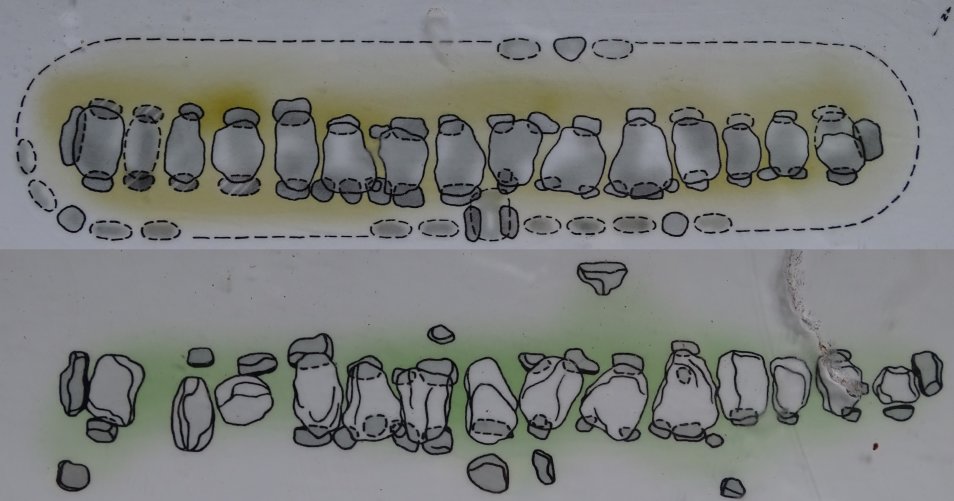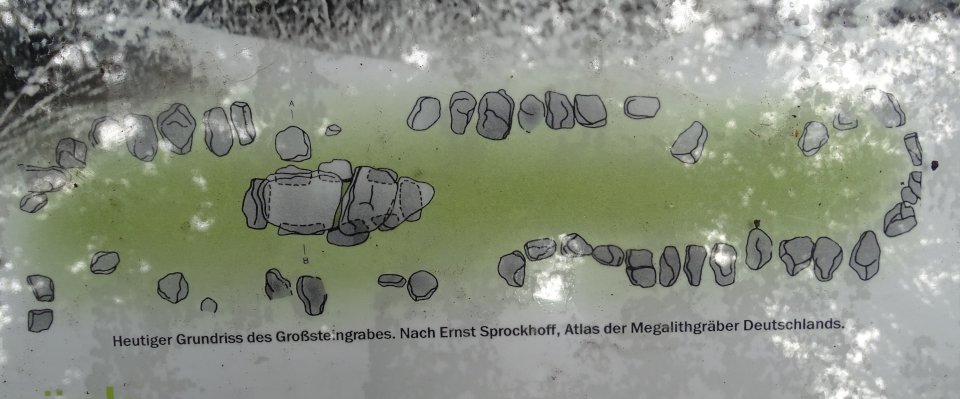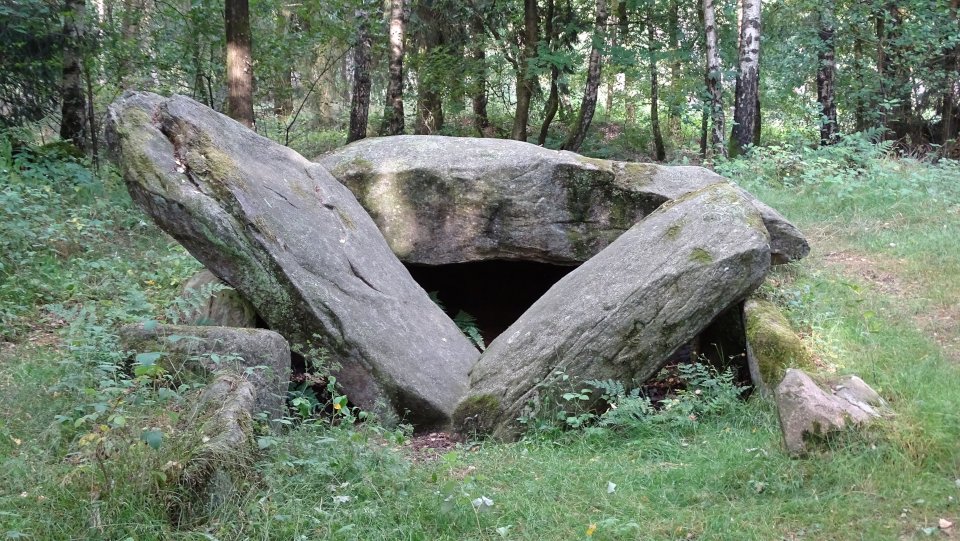





330 kilometres of scenic route lead you to 33 exciting archaeological sites through Northwest Germany. On your way you will find more than 70 Neolithic (3.500 to 2.800 B.C.) megalithic tombs.
The only, if only in remnants survived megalithic tomb in Vress are the Plingenberger Steine. There are still 3 capstones (one of which is incomplete), six supporting stones and a stone of the enclosure. 1895 were probably still 15 supporting stones available. The burial chamber is oriented in northwest-southeast direction. The length has to be at least 10 meters at 2 meters width.
To get to the tomb drive from Peheim to Vrees and turn right into Gehlenberger Weg and proceed northwards. After about 2.5 km turn right into a small road and continue for another 160 m . You should notice a small information board on the right. The tomb lies 30m behind this board in the wood.
Visited July 2018




taken from the Route of Megalithic Culture information board:
This megalithic grave is a perfectly preserved treasure trove according to legend. Satan wanted to hide his treasures under the impressive capstones of this 6 x 1.5 metre chamber. Expert groups are puzzeld primarily by the enclosure because it is still undetermined whether it was rectangular or oval. But it differs distinctively from other sites in the area because of its size of 6 x 40 metres. It is said that the number of stones of this devilish monument changes constantly. However, this may easily checked by counting on site. And if one looks closely at least one inscription may be found – dated to the 20th century though.

The burial chamber in its enclosure
Revisited July 2018



Runic inscription Anno Santo on the western capstone
Revisited July 2018

Today’s ground plan of the megalithic tomb. After Ernst Sprockhoff, Atlas of the megalithic tombs of Germany.
Revisited July 2018









330 kilometres of scenic route lead you to 33 exciting archaeological sites through Northwest Germany. On your way you will find more than 70 Neolithic (3.500 to 2.800 B.C.) megalithic tombs.
330 kilometres of scenic route lead you to 33 exciting archaeological sites through Northwest Germany. On your way you will find more than 70 Neolithic (3.500 to 2.800 B.C.) megalithic tombs.
330 kilometres of scenic route lead you to 33 exciting archaeological sites through Northwest Germany. On your way you will find more than 70 Neolithic (3.500 to 2.800 B.C.) megalithic tombs.
330 kilometres of scenic route lead you to 33 exciting archaeological sites through Northwest Germany. On your way you will find more than 70 Neolithic (3.500 to 2.800 B.C.) megalithic tombs.


Stüvenmühle 1 is the only surviving tomb of formerly five megalithic tombs in the district of Stüvenmühle. The tomb lies on the western edge of Visbek near the stream Aue in the garden of the residential building of the estate Stüvenmühle. It is therefore not open for the public.
When I visited the site, the owner just arrived so I asked for permission to visit the tomb. I got the permission, but was not allowed to take any pictures and had to leave my photo at the entrance. The owner accompanied me and meticulously made sure that I did not take pictures with my cell phone. She explained it to me in conversation that people kept appearing unasked in their garden, climbing over fences and damaging them. Therefore, they do not want images of the site on the internet to encourage even more people to visit the tomb.
All in all this is a nice tomb, probably only the burial chamber of a former Hunebed, the enclosure is completely missing. But please respect the wish of the landowner and ask for permission, before you visit the site.
Visited July 2018
To be honest during my visit 2018 there was not much to recognize of the megalithic tomb Bakenhus anymore, as the tomb is heavily overgrown in the meantime. During the planing of my visit I stumbled upon various images on various websites, were the tomb was show after some restoration / cleanup work 2007. It seems that since that no further maintenance work has been carried out, as the vegetation swallows the tomb now.
The tomb is nordwest-southeast oriented and spreads over 25m in a long, flat hill. Most of the support stones still seems to be present. To find the site drive from Ahlhorn on the B312 towards Wildeshausen. Right behind Ahlhorn turn left onto the K239 and drive northward for about 3.5 km. Turn right in the road Bakenhuser Esch and continue for about 165m. The tomb lies to the right in the wood, opposite of a riding facility.
It is a pity that evidently nobody cares about the tomb anymore.
Visited July 2018
lots of images after the clean-up work 2007, so you see, how the tomb looks like without the heavy vegetation





The east-west oriented trapezoidal eastern of the two tombs Ahlhorner Kellersteine 2 is located in a round hill of 14 m diameter. The chamber has a length of six meters. Their width decreases from 2.5 to 2.0 m. The two long sides of the chamber have four support stones. Of the formerly at least three capstones, one is still present in situ, the other was blown up and lies collapsed in the tomb.
Visited July 2018
The northwest-southeast-oriented western tomb Ahlhorner Kellersteine 1 is a trapezoidal tomb (type Emsland chamber) of eleven meters in length and a width of 3.0 to 2.3 meters. Of the once 17 support stones, 15 have been preserved, as well as all five capstones, but two of them have been dismembered. The largest capstone is 4.5 × 2.1 × 1 meter. On the south side the access to the chamber should have been located. From the original enclosure stones or the mound nothing is preserved.
Visited July 2018
West of Wildeshausen, south of the A1 autobahn there are three groups of 2 megalithic tombs each with the name affix “Kellersteine”, the Steinloger Kellersteine, the Holzhauser Kellersteine and the Ahlhorner Kellersteine described here.
You can reach the Ahlhorner Kellersteine if you continue on the Bride Path from the Visbeker Bräutigam for about 750m. You come to a crossroads at a field where two roads come from the left. Take the second one leading northeast and after 200m a sign points the way to the right to the two tombs, which are about 50m in the woods.
Visited July 2018
taken from the “Faszination Archäologie” information board:
“Ahlhorner Kellersteine”
Neolithic megalithic tomb
Dimensions Tomb I: 11 x 3 or 2 m, Tomb II; 6 x 2 or 2.5 m
The “Ahlhorner Kellersteine” have a relatively good state of preservation. The capstone of Tomb II was only blown up at the beginning of the 20th century. Today, his fragments can be considered as a memorial of wanton megalithic destruction. The term “Kellersteine” (cellar stones) is probably based on the folkloric misinterpretation of the tombs as a storage cellar for goods.
The legend of the miracle stone
(De Wunnersteen)
According to legend, one of the capstones originally bore the inscription “O wunnder, o wunner, wat ligg hier wohl unner?” (Oh wonder, oh wonder, what may lie down there?). After a long puzzling, it was said, the capstone had been raised. But you could find nothing, nothing except the inscription “Dat würd nu uck all hoge Tied, Dat ick mal keem upp de annere Siet!” (Now it’s about time that I get to the other side!)
Testimony of sedentary life
Megalithic tombs like the “Alhhorner Kellersteine” are considered the oldest surviving structures of northern Central Europe. Until the fourth millennium BC only hunters and gatherers lived in the Wildeshauser Geest. Only the “funnel beaker culture” (about 3500 – 2700 BC) settled down permanently.
They bred cattle, planted grain and lived in post constructions. Presumably, they believed in an otherworldly life and therefore built their deceased sometimes monumental graves of boulders. Those megalithic graves or megalithic tombs (Greek: mega = large, lithos = stone) were erected not for individuals, but for groups and used over many generations.





what a capstone! Ahlhorner Kellersteine 1 in the background top left
Visited July 2018

